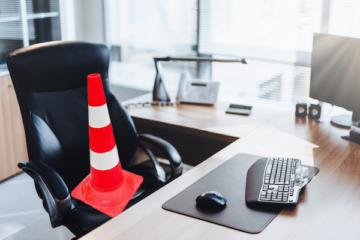Improve effectiveness by tidying up
I spent much of the weekend tidying up my physical work space. Because I moved a week ago, I spent the week living out of suitcases and working out of cardboard boxes.
I’ve always been pretty adaptable. I am game to make a go of whatever situation arises. (Which is the main reason I need good planners in my life.) So working in a temporary, mildly chaotic space wasn’t difficult for me.

I’ve learned over the last 15 years that this kind of clutter and chaos stimulates my creativity. I wrote most of my novels and a lot of my poetry in cafés and coffee shops. When I need to brainstorm or “think outside the box,” I do better in a physical space that refuses to conform to strict geometries and rigid motions.
Tidying up space
I also know that having visual clutter around me is like visual static—it creates a kind of mental hiss in the background, even when I’m not consciously focused on it.
So when I really need to concentrate, that mental hiss from all that visual clutter gives me this vague, unsettled sense that something else is always calling for my attention.
Whenever the office clutter builds up to a certain point, I need to tidy it up. Even if that’s just straightening the piles of papers on my desk. It helps.
One of my clients has this in spades. He told me he can’t get any work done at all if his office isn’t completely neat. For him, a small investment of time tidying up results in a huge boost in work effectiveness.
Tidying up time
That particular client is also affected by a cluttered mental workspace. An unexpected meeting showing up on his calendar throws him off. Slack’s message notifications are like a toddler constantly kicking the back of his chair. He’s got multiple projects with separate deliverables and dependencies.
He’s in a constant overwhelm of the mental equivalent of air traffic control at the world’s busiest airport.
Just as tidying up the clutter in his physical space reduces distractions and improves his concentration, tidying up the demands for his attention will make him more effective, reduce his stress and feelings of overwhelm, and give him a greater feeling of control over his time.
He’s not the only one, of course. I work with a lot of people who misdiagnose their inability to concentrate. They call it poor time management skills, or they self-diagnose an attention deficit disorder, when really it has more to do with a highly chaotic mental environment.
It’s like calling yourself a bad driver because it takes you a half hour to go two miles, but you fail to acknowledge the construction, red lights, pedestrians, congestion, accidents, and all the other things that make speedy driving impossible.

generated by Adobe Firefly
Five methods for tidying up your mental space
When you have to drive somewhere, you can’t tidy up traffic, pedestrians, and construction. You just have to plan around the things that are outside your control. In driving, that means finding an efficient route and giving yourself enough time to get to your destination.
At work, there are a lot of things outside your control. You can’t control when the internet goes down, or if a coworker calls in sick, or if your mission-critical vendor unexpectedly goes out of business at 2 p.m. on a Monday in June. (That was an unforgettable day.)
But there are a lot of things you can do to tidy up your mental space to improve your ability to concentrate. You can find a lot more just by checking in with AI, but here are the ones that my clients have reported as working well for them.
Put boundaries on your availability, and keep them
The only person interested in your boundaries is you. No one else knows everything you’ve got going on. They only know what they need from you. So set boundaries on your time, attention, and responsiveness… and then hold fast to them. Teach yourself not to respond to every question, email, or Slack immediately. People will learn what you train them, and when you train them that you are ultra-responsive, they get the sense that (a) you will always respond immediately, and (b) you don’t have anything else important going on.
Mute or customize notifications
Every notification is a triage event. You got a Slack message! Is it important? Is it urgent? Who knows? Better go look at it to be sure. Get used to muting notifications when you need to concentrate. I always go on “do not disturb” when I’m in a client meeting, for example. If your notifications allow for customization, use it. I use different buzz patterns with my phone to know immediately which family member is texting, for example.
Create time for transition or mental reset
In this new world of video meetings, we often go directly from one video call to another, without any break between. A lot of my clients spend the first five minutes of our session apologizing for not being better prepared because they just got out of another meeting. It’s no problem for me; it’s their own time and energy they are throwing away. Just five minutes of transition time can make a world of difference. You’ll show up to that next meeting sharper, less frazzled, and more attentive. Similarly, create time after important meetings to settle, process, and document the critical takeaways. Most calendaring software allows for setting buffer time around events, or automatically rejecting requests that abut existing meetings.
Filter your emails
One of my clients recently created email filters that automatically direct most of her incoming emails into specific folders. This works exceptionally well for her, especially because a lot of her inbox clutter is things she gets cc’d on as a manager but doesn’t have to look at. Filtering on the sender and predictable keywords, she can get control of her inbox and then go check the non-priority emails when she has time. Be careful about having things go “out of sight, out of mind,” however—be diligent about looking in those folders for emails you might have missed.
Prioritize your to-do lists
The same client who uses filters to triage her inbox also has a simple, visual way to prioritize her to-do lists. She uses red, yellow, and white sticky notes to create high, medium, and regular priority to-do lists every morning and track them throughout the day. I’m not a fan of the waste it creates (1,000 sticky notes a year), so consider a digital equivalent. The process, however, is sound: She can easily and quickly keep track of her highest priorities, and pull from the next-level priorities when she has time throughout the day.
The one that’s best is the one you actually do
As with every method and technique, your mileage may vary. You need to find what will work for you.
For example, my list above doesn’t include blocking time on your calendar for those tasks that you never quite find time to do. That’s because my clients report that it doesn’t work. In fact, I cannot think of a single case I know personally where that was an effective, sustainable solution.
If that’s worked for you as a sustainable solution, then please let me know. You’d be the first.
I can help.
I work with top executives and middle managers to improve their leadership skills, their workplace culture, and the effectiveness of their teams. Also, I help individuals identify and achieve their personal goals. Would you like to become more aware, be more effective, be more empowered, and feel fully prepared for your next steps?
You can help.
Think of one person who would benefit from reading this post. Sharing is caring! Forward it to them right now. They will think you’re super smart and well informed.
Stay smart and well informed.
Be sure to join my email list! Get notified of new posts here as well as new courses, books, and events from me both here and at Gray Bear Publications.



0 Comments